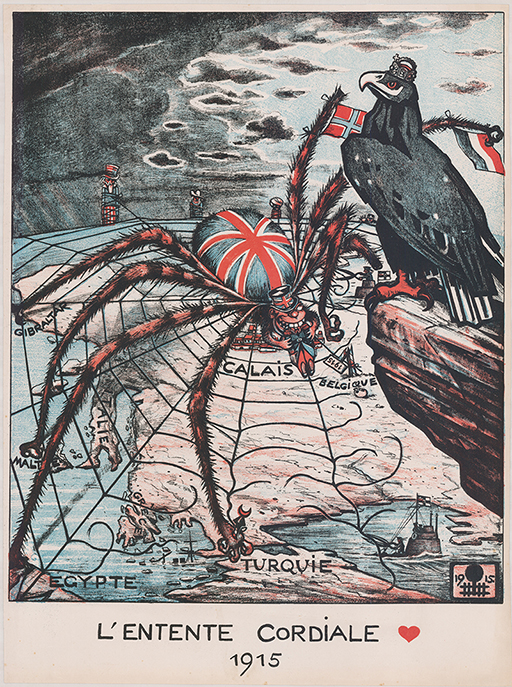3.1 German propaganda – Example 1
The first example of German propaganda is a poster from 1915.
Activity 5 Primary source analysis
The first example is the propaganda poster: ‘L’Entente Cordiale’ from 1915. Look at the contextual information provided and consider the questions we pose for analysing this source. You have the option to consider each question yourself before revealing our specimen answers or you can use our worked example for students’ skills development.
When?
Answer
The map was published in 1915. At this early stage in the war, German propagandists attempted to justify the nation’s reasons for going to war by blaming the outbreak of the conflict on foreign aggression.
What?
Answer
The poster depicts a map of Europe and various caricatures of the major world powers. Dominating the image is Great Britain, depicted as a giant spider with long legs stretching across the entire continent. In place of the spider’s head is a man with a top hat – this is ‘John Bull’, the personification of Britain.
The spider sits in a web that engulfs all of France, while Germany is depicted as a proud eagle on a perch overlooking the spider. In the background, we can also see Uncle Sam, the personification of the USA, caught in the spider’s web. In the sea, submarines are cutting through the spider’s web.
The poster’s caption – L’Entente Cordiale – is a reference to the diplomatic agreement signed between France and Britain in 1904. Turkey, Germany’s ally in the war, is also labelled on the map and presented as under threat from British expansionism.
How?
Answer
To make these points, the artist has employed a number of techniques typically used by satirical cartoonists. By using recognisable symbols (the British flag, John Bull, Uncle Sam), the artist has ensured that all the major powers in this cartoon are instantly recognisable. The large spider (often perceived as an aggressive, ugly and fearsome animal) dominates the image and is used to demonise the enemy. The use of the French language is also a clear attempt to appeal to a specific audience.
Purpose
Answer
This poster portrays Germany’s war effort as a defensive necessity in the face of the aggressive, expansionist policies of Britain. It also implies that other major nations – including Britain’s ally France and the neutral USA – are under the thrall of this aggressive power.
The depiction of the German submarines, which appear to be gradually destroying the spider’s web, promote one of Germany’s major strategies during the war, which aimed to disrupt Allied shipping. The major countries on the map are labelled in French (Belgique, Egypte, Turquie etc.), which suggests that this poster was intended for French as well as German audiences, with the aim of causing the French to question their alliance with Britain.
Uses for historians
Answer
This poster provides important evidence of how German propagandists sought to portray their war effort as defensive rather than aggressive. It is also a useful example of propaganda intended for an enemy audience. However, there are reasons to be sceptical regarding the effectiveness of propaganda like this. France did of course continue to fight, not least because it had been invaded by Germany. Indeed, German efforts to portray itself as the victim were undone by the fact that its army had invaded Belgium and France upon the outbreak of the war. German audiences, however, may have been more receptive to the poster’s message, though this is difficult to gauge.
Did you know?
Some contextual information about this poster is available on the website of Cornell University Library [Tip: hold Ctrl and click a link to open it in a new tab. (Hide tip)] .

